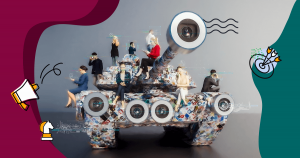Sara Krugman and Momo Miyazaki are currently studying at the Copenhagen Institute of Interaction Design in Denmark, where they created a visualization of danish rye bread as part of their studies. They are both obsessed with details. The Table of Danish Rye Bread Elements is an exploration of the contents and nutrients of various seed-heavy rye loaves. Both of us are from the United States, where we have bountiful amounts of glutinous baked goods. We recently moved to Denmark, where rye bread, or rugbrød, is the base for traditional sandwiches. Its nutritional value and complexity are incomparable to our beloved New York bagels.
The contents of the bread seemed complex… what is it made of? How healthy is it? What’s in it that makes it so heavy? There were many questions about the dense Danish rugbrød, so it was time to investigate. Three different loaves of rye bread were dissected by hand and each element was weighed. Our excitement to dissect the bread manually and the anticipation of the results motivated our eight hours of slightly obsessive yet serene concentration. 
Technology allows for the collection and visualization of large scale data sets – this is an incredibly powerful way to see the world around us. Part of what excites us about data visualization is the outcome of an alternative perspective of everyday information. We saw a lot of projects that visualize large scale data sets (population, geography, etc.) through algorithms that filter and organize the information. It is incredible to be able to see such vast amounts of data in relevant ways, but using our own hands seemed appropriate for our small-scale exploration of the traditional craftwork. We were excited to use the data viz method of thinking on a smaller scale, to look at the things we encounter every day.
Sara Krugman in an Interaction designer studying at CIID. She works to connect health care products, services and systems. She is a Cofounder of Line, tweets as @skrugman, blogs here and lives in this city. Momo Miyazaki is an interaction designer with a background in metalsmithing. She loves to make beautiful things and is now focusing on creating beautiful interactions.










